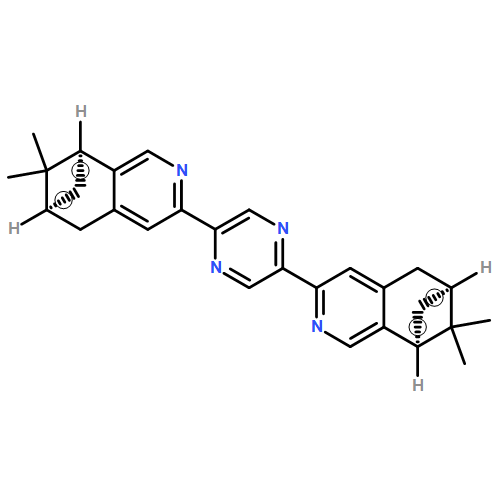Co-reporter: Xi-Li Li, Zhiqiang Zhang, Xue-Li Zhang, Jia-Long Kang, Ai-Ling Wang, Liming Zhou and Shaoming Fang
pp: 4180-4185
Publication Date(Web):15 Jan 2015
DOI: 10.1039/C4DT03884C
The reaction of enantiomeric bis-bidentate bridging ligands (+)/(−)-2,5-bis(4,5-pinene-2-pyridyl)pyrazine (LS/LR) with [Re(CO)5Cl] yielded a pair of dinuclear Re(I) enantiomers formulated as [Re2(LS/LR)(CO)6Cl2]·4CH2Cl2 (R-1 and S-1, the isomers containing the respective LR and LS ligands). They were characterized by elemental analyses, IR spectra and X-ray crystallography. Circular dichroism spectra verified their chiroptical activities and enantiomeric nature. The measurements of second harmonic generation (SHG) and ferroelectric properties showed that R-1 displays a nonlinear optical (NLO) activity and ferroelectricity with a remnant polarization (Pr) of 1.6 μC cm−2 under an applied field of 7.3 kV cm−1 at room temperature. R-1 and S-1 represent the first example of polynuclear Re(I) complexes with ferroelectric properties. Notably, the Pr value is much larger than that of the reported mononuclear chiral Re(I) analogue. In particular, unlike mononuclear Re(I) complexes of the type [Re(CO)3(N^N)(X)] (N^N = diimine and X = halide), which usually exhibit an intense emission in the visible range, R-1 and S-1 do not show any detectable emission at any temperature range and the reason for the nonluminescence of R-1 and S-1 was further elucidated in this work. Moreover, our research results also elucidated that Re nuclearity has a great influence on not only the emitting properties but also on ferroelectric behavior.
Co-reporter: Xi-Li Li, Zhiqiang Zhang, Xue-Li Zhang, Jia-Long Kang, Ai-Ling Wang, Liming Zhou and Shaoming Fang
pp: NaN4185-4185
Publication Date(Web):2015/01/15
DOI: 10.1039/C4DT03884C
The reaction of enantiomeric bis-bidentate bridging ligands (+)/(−)-2,5-bis(4,5-pinene-2-pyridyl)pyrazine (LS/LR) with [Re(CO)5Cl] yielded a pair of dinuclear Re(I) enantiomers formulated as [Re2(LS/LR)(CO)6Cl2]·4CH2Cl2 (R-1 and S-1, the isomers containing the respective LR and LS ligands). They were characterized by elemental analyses, IR spectra and X-ray crystallography. Circular dichroism spectra verified their chiroptical activities and enantiomeric nature. The measurements of second harmonic generation (SHG) and ferroelectric properties showed that R-1 displays a nonlinear optical (NLO) activity and ferroelectricity with a remnant polarization (Pr) of 1.6 μC cm−2 under an applied field of 7.3 kV cm−1 at room temperature. R-1 and S-1 represent the first example of polynuclear Re(I) complexes with ferroelectric properties. Notably, the Pr value is much larger than that of the reported mononuclear chiral Re(I) analogue. In particular, unlike mononuclear Re(I) complexes of the type [Re(CO)3(N^N)(X)] (N^N = diimine and X = halide), which usually exhibit an intense emission in the visible range, R-1 and S-1 do not show any detectable emission at any temperature range and the reason for the nonluminescence of R-1 and S-1 was further elucidated in this work. Moreover, our research results also elucidated that Re nuclearity has a great influence on not only the emitting properties but also on ferroelectric behavior.
Co-reporter: Xi-Li Li, Yu-Liang Gao, Xiang-Li Feng, You-Xuan Zheng, Chun-Lai Chen, Jing-Lin Zuo and Shao-Ming Fang
pp: 11829-11835
Publication Date(Web):01 Aug 2012
DOI: 10.1039/C2DT31007D
Using the enantiomeric bis-bidentate bridging ligands (+)/(−)-2,5-bis(4,5-pinene-2-pyridyl)pyrazine (LS/LR) and depending on the ratio control of reactants, two mono- and dinuclear Eu(III)-based enantiomeric pairs with the formulae Eu(dbm)3LR/S·2H2O (LR in R-1, LS in S-1 and dbm = dibenzoylmethanato) and Eu2(dbm)6LR/S·H2O (LR in R-2 and LS in S-2) have been stereoselectively synthesized and structurally characterized. The circular dichroic (CD) spectra confirmed their chiroptical activities and enantiomeric natures. The homochiral dinuclear species represents the first example of a polynuclear lanthanide β-diketonate complexes with circular dichroic and crystallographic evidences. The photoluminescent properties studies revealed that both mono- and dinuclear Eu(III) complexes exhibited the characteristic red emissions of Eu(III) ions in the solid state (at 77 K and 300 K) and CH2Cl2 solution. Notably, the photophysical properties of the mononuclear enantiomers were superior to the dinuclear species. Interestingly, R-2 displayed a ferroelectric property at room temperature, which was not observed for R-1 due to the lack of crystalline polarity. R/S-2 are the first examples of homochiral polynuclear lanthanide complexes with luminescence and ferroelectric properties, being potential multifunctional materials.
Co-reporter: Xi-Li Li, Yu-Liang Gao, Xiang-Li Feng, You-Xuan Zheng, Chun-Lai Chen, Jing-Lin Zuo and Shao-Ming Fang
pp: NaN11835-11835
Publication Date(Web):2012/08/01
DOI: 10.1039/C2DT31007D
Using the enantiomeric bis-bidentate bridging ligands (+)/(−)-2,5-bis(4,5-pinene-2-pyridyl)pyrazine (LS/LR) and depending on the ratio control of reactants, two mono- and dinuclear Eu(III)-based enantiomeric pairs with the formulae Eu(dbm)3LR/S·2H2O (LR in R-1, LS in S-1 and dbm = dibenzoylmethanato) and Eu2(dbm)6LR/S·H2O (LR in R-2 and LS in S-2) have been stereoselectively synthesized and structurally characterized. The circular dichroic (CD) spectra confirmed their chiroptical activities and enantiomeric natures. The homochiral dinuclear species represents the first example of a polynuclear lanthanide β-diketonate complexes with circular dichroic and crystallographic evidences. The photoluminescent properties studies revealed that both mono- and dinuclear Eu(III) complexes exhibited the characteristic red emissions of Eu(III) ions in the solid state (at 77 K and 300 K) and CH2Cl2 solution. Notably, the photophysical properties of the mononuclear enantiomers were superior to the dinuclear species. Interestingly, R-2 displayed a ferroelectric property at room temperature, which was not observed for R-1 due to the lack of crystalline polarity. R/S-2 are the first examples of homochiral polynuclear lanthanide complexes with luminescence and ferroelectric properties, being potential multifunctional materials.


